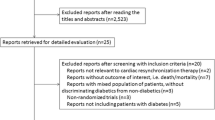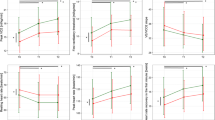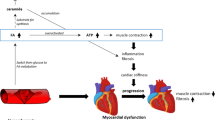Abstract
Heart failure (HF) and type 2 diabetes mellitus (T2DM) exhibit a well-established interrelationship and a growing prevalence, in particular in elderly people. Cardiac resynchronization therapy (CRT) has been shown to improve myocardial function in patients with HF and cardiac dyssynchrony. However, reports on CRT in diabetic elderly patients are limited and controversial. Therefore, the aim of the present study was to investigate the functional role of T2DM on the effectiveness of CRT at advanced age. In this single-center prospective study, we enrolled 72 HF patients over 75 years old with and without T2DM who underwent CRT implant. Detailed clinical and instrumental data, including cardiac ultrasound analysis, 6-min walk test, and quality-of-life evaluation, were collected at baseline and at 1-year follow-up. At the time of implantation, 44.4 % of patients had T2DM, of which 62.5 % were well controlled with diet and hypoglycemic drugs and 37.5 % were treated by insulin therapy. After 1 year, CRT improved myocardial ventricular geometry and functional capacity in a comparable proportion of diabetic and non-diabetic patients alongside with a similar amelioration in the functional status. Taken together, our findings demonstrate that diabetic patients >75 years old exhibit a response to CRT that is comparable to non-diabetic subjects.
Similar content being viewed by others
References
Eurich, D. T., Weir, D. L., Majumdar, S. R., Tsuyuki, R. T., Johnson, J. A., Tjosvold, L., et al. (2013). Comparative safety and effectiveness of metformin in patients with diabetes mellitus and heart failure: systematic review of observational studies involving 34,000 patients. Circulation Heart Failure, 6(3), 395–402.
Santulli, G. (2013). Epidemiology of cardiovascular disease in the 21st century: updated numbers and updated facts. Journal of Cardiovascular Disease (JCvD), 1(1), 1–2.
Huang, E.S., Laiteerapong, N., Liu, J.Y., John, P.M., Moffet, H.H., Karter, A.J. (2013). Rates of complications and mortality in older patients with diabetes mellitus: The Diabetes and Aging Study. JAMA Internal Medicine.
Peterson, L. R., McKenzie, C. R., & Schaffer, J. E. (2012). Diabetic cardiovascular disease: getting to the heart of the matter. Journal of Cardiovascular Translational Research, 5(4), 436–445.
Cubbon, R. M., Adams, B., Rajwani, A., Mercer, B. N., Patel, P. A., Gherardi, G., et al. (2013). Diabetes mellitus is associated with adverse prognosis in chronic heart failure of ischaemic and non-ischaemic aetiology. Diabetes & Vascular Disease Research: Official Journal of the International Society of Diabetes and Vascular Disease, 10(4), 330–336.
Nodari, S., Manerba, A., Vaccari, A., Milesi, G., Carubelli, V., Lazzarini, V., et al. (2012). Six-year prognosis of diabetic patients with coronary artery disease. European Journal of Clinical Investigation, 42(4), 376–383.
Moss, A. J., Hall, W. J., Cannom, D. S., Klein, H., Brown, M. W., Daubert, J. P., et al. (2009). Cardiac-resynchronization therapy for the prevention of heart-failure events. The New England Journal of Medicine, 361(14), 1329–1338.
Peterson, P. N., Greiner, M. A., Qualls, L. G., Al-Khatib, S. M., Curtis, J. P., Fonarow, G. C., et al. (2013). QRS duration, bundle-branch block morphology, and outcomes among older patients with heart failure receiving cardiac resynchronization therapy. JAMA: The Journal of the American Medical Association, 310(6), 617–626.
Hoke, U., Thijssen, J., van Bommel, R. J., van Erven, L., van der Velde, E. T., Holman, E. R., et al. (2013). Influence of diabetes on left ventricular systolic and diastolic function and on long-term outcome after cardiac resynchronization therapy. Diabetes Care, 36(4), 985–991.
Fantoni, C., Regoli, F., Ghanem, A., Raffa, S., Klersy, C., Sorgente, A., et al. (2008). Long-term outcome in diabetic heart failure patients treated with cardiac resynchronization therapy. European Journal of Heart Failure, 10(3), 298–307.
Hoppe, U. C., Freemantle, N., Cleland, J. G., Marijianowski, M., & Erdmann, E. (2007). Effect of cardiac resynchronization on morbidity and mortality of diabetic patients with severe heart failure. Diabetes Care, 30(3), 722–724.
Mangiavacchi, M., Gasparini, M., Genovese, S., Pini, D., Klersy, C., Bragato, R., et al. (2008). Insulin-treated type 2 diabetes is associated with a decreased survival in heart failure patients after cardiac resynchronization therapy. Pacing and Clinical Electrophysiology: PACE, 31(11), 1425–1432.
Martin, D. T., McNitt, S., Nesto, R. W., Rutter, M. K., & Moss, A. J. (2011). Cardiac resynchronization therapy reduces the risk of cardiac events in patients with diabetes enrolled in the multicenter automatic defibrillator implantation trial with cardiac resynchronization therapy (MADIT-CRT). Circulation Heart Failure, 4(3), 332–338.
Soliman, O. I., van Dalen, B. M., Theuns, D. A., ten Cate, F. J., Nemes, A., Jordaens, L. J., et al. (2009). The ischemic etiology of heart failure in diabetics limits reverse left ventricular remodeling after cardiac resynchronization therapy. Journal of Diabetes and its Complications, 23(5), 365–370.
Bleeker, G. B., Schalij, M. J., Molhoek, S. G., Boersma, E., Steendijk, P., van der Wall, E. E., et al. (2005). Comparison of effectiveness of cardiac resynchronization therapy in patients <70 versus > or =70 years of age. American Journal of Cardiology, 96(3), 420–422.
Pulignano, G., Del Sindaco, D., Tavazzi, L., Lucci, D., Gorini, M., Leggio, F., et al. (2002). Clinical features and outcomes of elderly outpatients with heart failure followed up in hospital cardiology units: data from a large nationwide cardiology database (IN-CHF Registry). American Heart Journal, 143(1), 45–55.
Fumagalli, S., Valsecchi, S., Boriani, G., Gasparini, M., Landolina, M., Lunati, M., et al. (2011). Comparison of the usefulness of cardiac resynchronization therapy in three age-groups (<65, 65–74 and >/=75 years) (from the InSync/InSync ICD Italian Registry). American Journal of Cardiology, 107(10), 1510–1516.
Cleland, J. G., Daubert, J. C., Erdmann, E., Freemantle, N., Gras, D., Kappenberger, L., et al. (2005). The effect of cardiac resynchronization on morbidity and mortality in heart failure. The New England Journal of Medicine, 352(15), 1539–1549.
Epstein, A. E., DiMarco, J. P., Ellenbogen, K. A., Estes, N. A., 3rd, Freedman, R. A., Gettes, L. S., et al. (2008). ACC/AHA/HRS 2008 Guidelines for device-based therapy of cardiac rhythm abnormalities: a report of the American College of Cardiology/American Heart Association Task Force on Practice Guidelines (Writing Committee to Revise the ACC/AHA/NASPE 2002 Guideline Update for Implantation of Cardiac Pacemakers and Antiarrhythmia Devices) developed in collaboration with the American Association for Thoracic Surgery and Society of Thoracic Surgeons. Journal of the American College of Cardiology, 51(21), e1–e62.
Vardas, P. E., Auricchio, A., Blanc, J. J., Daubert, J. C., Drexler, H., Ector, H., et al. (2007). Guidelines for cardiac pacing and cardiac resynchronization therapy: the Task Force for Cardiac Pacing and Cardiac Resynchronization Therapy of the European Society of Cardiology. Developed in collaboration with the European Heart Rhythm Association. European Heart Journal, 28(18), 2256–2295.
D’Ascia, S. L., D’Ascia, C., Marino, V., Lombardi, A., Santulli, R., Chiariello, M., et al. (2011). Cardiac resynchronisation therapy response predicts occurrence of atrial fibrillation in non-ischaemic dilated cardiomyopathy. International Journal of Clinical Practice, 65(11), 1149–1155.
Santulli, G., D’Ascia, S., & D’Ascia, C. (2012). Regarding the impact of left ventricular size on response to cardiac resynchronization therapy. American Heart Journal, 163(4), e11.
Santulli, G., & D’Ascia, C. (2012). Atrial remodelling in echocardiographic super-responders to cardiac resynchronization therapy. Heart, 98(6), 517.
Crete, J. E., & Anasti, J. N. (2013). Diagnosis of gestational diabetes mellitus: can we avoid the glucose challenge test? Journal of the American Association of Nurse Practitioners, 25(6), 329–333.
Marfella, R., Di Filippo, C., Potenza, N., Sardu, C., Rizzo, M.R., Siniscalchi, M., et al. (2013). Circulating microRNA changes in heart failure patients treated with cardiac resynchronization therapy: responders vs. non-responders. European Journal of Heart Failure, 15(11), 1277–1288.
Jansen, A. H., van Dantzig, J., Bracke, F., Peels, K. H., Koolen, J. J., Meijer, A., et al. (2007). Improvement in diastolic function and left ventricular filling pressure induced by cardiac resynchronization therapy. American Heart Journal, 153(5), 843–849.
Banerjee, D., Biggs, M. L., Mercer, L., Mukamal, K., Kaplan, R., Barzilay, J., et al. (2013). Insulin resistance and risk of incident heart failure: Cardiovascular Health Study. Circulation Heart Failure, 6(3), 364–370.
Negishi, K., Seicean, S., Negishi, T., Yingchoncharoen, T., Aljaroudi, W., & Marwick, T. H. (2013). Relation of heart-rate recovery to new onset heart failure and atrial fibrillation in patients with diabetes mellitus and preserved ejection fraction. The American Journal of Cardiology, 111(5), 748–753.
Badimon, L., Hernández Vera, R., & Vilahur, G. (2013). Determinants of cardiovascular risk in diabetes beyond hyperglycemia. JCvD, 1(2), 53–62.
Mercer, B. N., Morais, S., Cubbon, R. M., & Kearney, M. T. (2012). Diabetes mellitus and the heart. International Journal of Clinical Practice, 66(7), 640–647.
Foley, P. W., Chalil, S., Khadjooi, K., Smith, R. E., Frenneaux, M. P., & Leyva, F. (2008). Long-term effects of cardiac resynchronization therapy in octogenarians: a comparative study with a younger population. Europace: European Pacing, Arrhythmias, and Cardiac Electrophysiology: Journal of the Working Groups on Cardiac Pacing, Arrhythmias, and Cardiac Cellular Electrophysiology of the European Society of Cardiology, 10(11), 1302–1307.
Martinez-Selles, M., Doughty, R. N., Poppe, K., Whalley, G. A., Earle, N., Tribouilloy, C., et al. (2012). Gender and survival in patients with heart failure: interactions with diabetes and aetiology. Results from the MAGGIC individual patient meta-analysis. European Journal of Heart Failure, 14(5), 473–479.
Cowie, M. R., Fox, K. F., Wood, D. A., Metcalfe, C., Thompson, S. G., Coats, A. J., et al. (2002). Hospitalization of patients with heart failure: a population-based study. European Heart Journal, 23(11), 877–885.
Davies, M., Hobbs, F., Davis, R., Kenkre, J., Roalfe, A. K., Hare, R., et al. (2001). Prevalence of left-ventricular systolic dysfunction and heart failure in the Echocardiographic Heart of England Screening study: a population based study. Lancet, 358(9280), 439–444.
Cutro, R., Rich, M. W., & Hauptman, P. J. (2012). Device therapy in patients with heart failure and advanced age: too much too late? International Journal of Cardiology, 155(1), 52–55.
Kramer, D. B., Reynolds, M. R., & Mitchell, S. L. (2013). Resynchronization: considering device-based cardiac therapy in older adults. Journal of the American Geriatrics Society, 61(4), 615–621.
Delnoy, P. P., Ottervanger, J. P., Luttikhuis, H. O., Elvan, A., Misier, A. R., Beukema, W. P., et al. (2008). Clinical response of cardiac resynchronization therapy in the elderly. American Heart Journal, 155(4), 746–751.
Faggiano, P., D’Aloia, A., Gualeni, A., Brentana, L., & Dei Cas, L. (2004). The 6 minute walking test in chronic heart failure: indications, interpretation and limitations from a review of the literature. European Journal of Heart Failure, 6(6), 687–691.
Lebovitz, H. E. (2011). Insulin: potential negative consequences of early routine use in patients with type 2 diabetes. Diabetes Care, 34(Suppl 2), S225–S230.
Inzucchi, S. E., Masoudi, F. A., Wang, Y., Kosiborod, M., Foody, J. M., Setaro, J. F., et al. (2005). Insulin-sensitizing antihyperglycemic drugs and mortality after acute myocardial infarction: insights from the National Heart Care Project. Diabetes Care, 28(7), 1680–1689.
Santulli, G., Ciccarelli, M., Trimarco, B., & Iaccarino, G. (2013). Physical activity ameliorates cardiovascular health in elderly subjects: the functional role of the beta adrenergic system. Frontiers in Physiology, 4, 209.
Uriel, N., Gonzalez-Costello, J., Mignatti, A., Morrison, K., Nahumi, N., Colombo, P., et al. (2013). Adrenergic activation, fuel substrate availability, and insulin resistance in patients with congestive heart failure. JACC Heart Failure, 1(4), 331–337.
Santulli, G. (2014). Adrenal signaling in heart failure: something more than a distant ship’s smoke on the horizon. Hypertension, 63(2), 215–216.
Acknowledgments
No potential conflicts of interest relevant to this article were reported. C.S. researched the data and reviewed/edited the manuscript. R.M. researched the data and reviewed the manuscript. G.S. researched and analyzed the data and wrote the paper. All the authors are guarantors of the work.
Author information
Authors and Affiliations
Corresponding author
Additional information
Associate Editor Craig Stolen oversaw the review of this article
Rights and permissions
About this article
Cite this article
Sardu, C., Marfella, R. & Santulli, G. Impact of Diabetes Mellitus on the Clinical Response to Cardiac Resynchronization Therapy in Elderly People. J. of Cardiovasc. Trans. Res. 7, 362–368 (2014). https://doi.org/10.1007/s12265-014-9545-9
Received:
Accepted:
Published:
Issue Date:
DOI: https://doi.org/10.1007/s12265-014-9545-9




